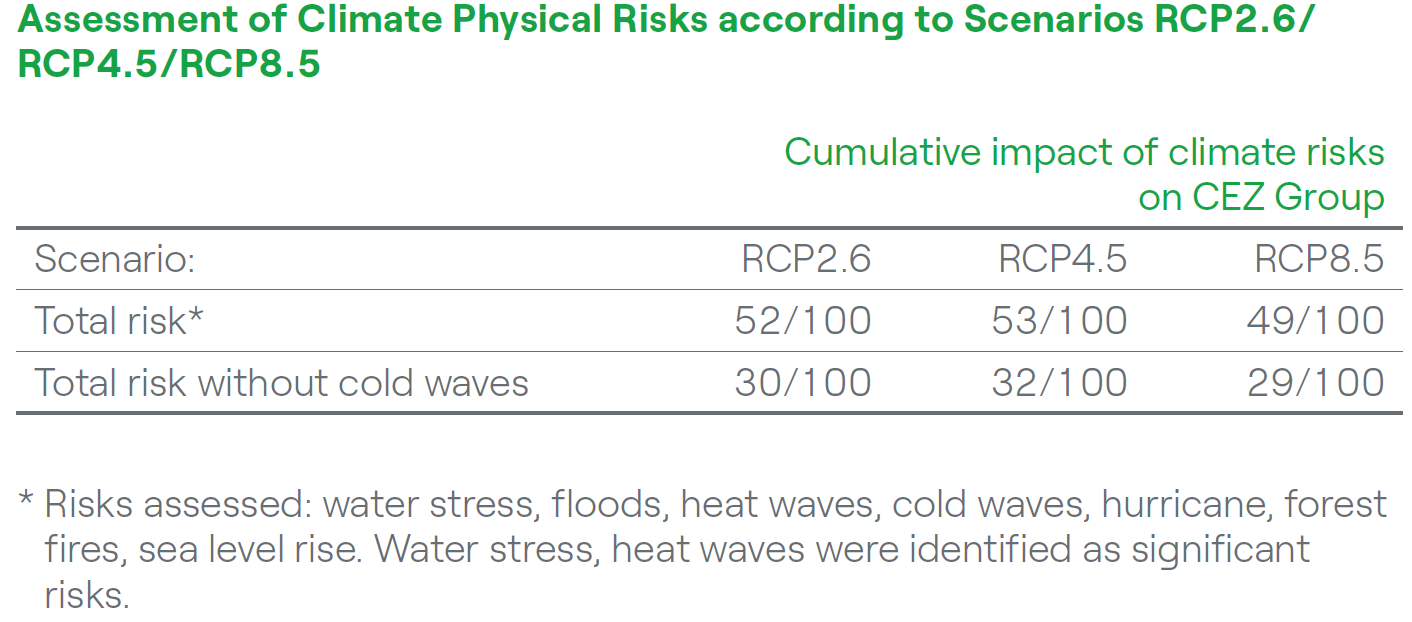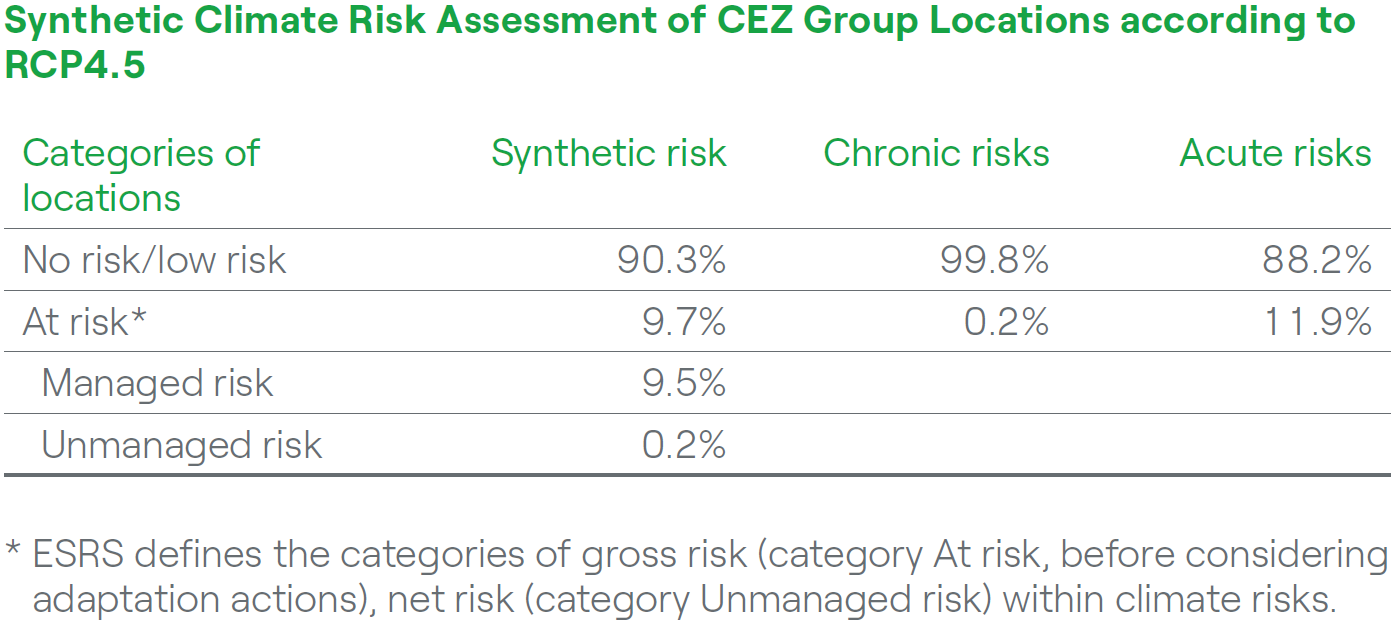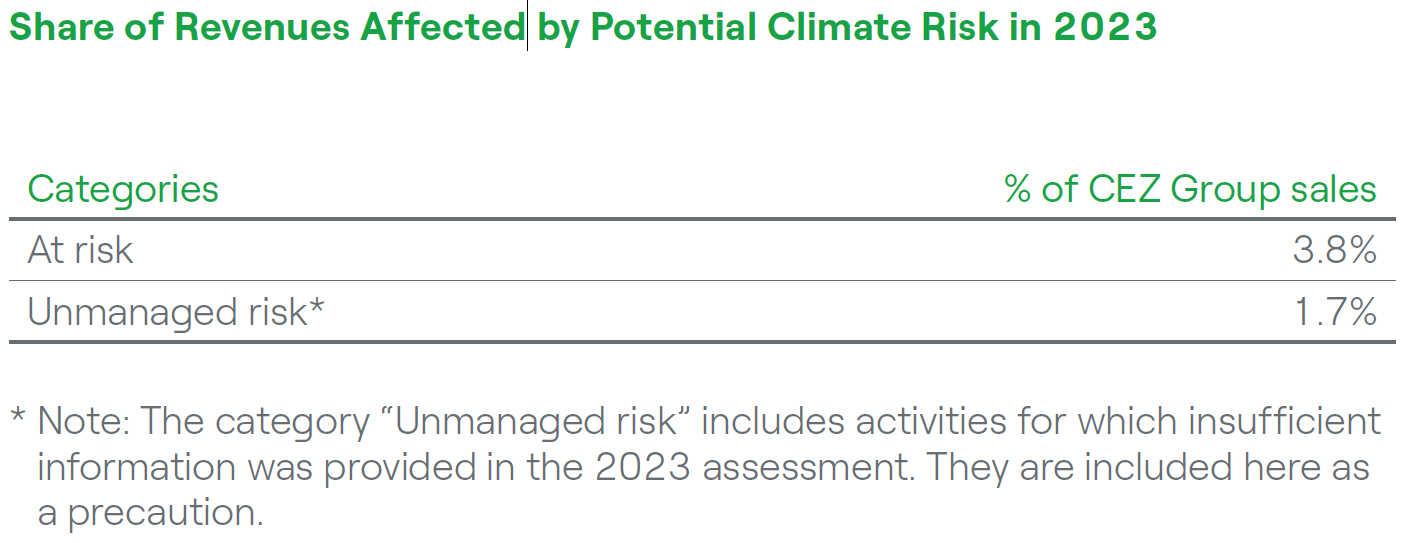Climate Risk Management and TCFD
GRI 3–3, 201–2; SASB IF–EU–110a.3 / SDG 13
CEZ Group recognizes that climate change poses serious risks to business and society. We are committed to mitigating and adapting to climate change. To operate sustainably, ethically and transparently, we must address climate–related risks and opportunities as part of our strategy.
In accordance with the TCFD, we apply the principle of double materiality to climate risks – we monitor (1) the impact of climate–related physical risks (i.e., floods, fires, earthquakes, landslides, lightning strikes, storms, and tornados) on
our facilities; and (2) the effects of our business on the environment and the climate. The effects are categorized as follows:
- Critical: material and irreversible impact on the environment and climate
- High: material impact with a long–term return to the original state
- Medium: impact with a mid–term return to the original state
- Low: immaterial impact with a low–cost short–term return to the original state
We recognize that climate–related risks are overarching, as they can trigger other types of risks (reputational, operational, financial). They can also jeopardize stakeholder relationships. We monitor the development of legislation, initiatives and trends and minimize transition risks.
In the spring of 2023, we published the first stand–alone TCFD report, available here, based on the TCFD recommendations and following the recommended structure.
Legal and Political Risk
CEZ Group operates emission sources and is subject to legal and regulatory risks. CEZ Group has been reducing this risk for a long time and already has a significant share of emission–free sources in its generation portfolio, and this share will continue to increase with the development of new renewable sources. At the CEZ Group level, our emission–free generation capacities allow us to offset the negative impact of carbon prices on operating coal–fired power plants by linking the price of the allowance to the market price of electricity. Long–term price risk is expected to decrease around 2035
following the successful implementation of the strategy VSION 2030—Clean Energy of Tomorrow. From a political and legal perspective, coal assets are also at higher risk of direct regulatory intervention (e.g., ordered decommissioning) and may be associated with potential reputational risk. These risks are actively managed and mitigated: future coal decommissioning and replacement of existing coal–fired locations with renewable or low–carbon assets are already included in the CEZ Group's VISION 2030—Clean Energy of Tomorrow strategy.
Technological risks
For CEZ Group, technological risk is associated with the transition to low–carbon technologies. Its potential impact is considered to be moderate, due to the already planned phase–out of coal–fired sources and the preparation of new gas–fired projects for the future transition to low–carbon fuels. CEZ Group invests significantly in technologies that are considered neutral or environmentally positive according to the EU taxonomy. This means renewable energy, smart grids and nuclear energy. In 2023, the share of sustainable investments reached 67.3%. Investments in coal mining and coal energy accounted for only 12.9% of total investments in 2023 and are only maintenance investments to ensure operations until the shutdown of these facilities.
Market risks
Short–term factors affecting electricity prices and volumes include onshore and offshore wind conditions, temperature, emissions allowance prices, fuel prices, economic developments and the import and export situation. These define the potential risks associated with the market. Market risks are assessed as part of CEZ Group's enterprise–wide risk assessment process.
Reputational risks
To manage and mitigate reputational risk, CEZ Group actively discloses corporate ESG data and increases the quality and scope of non–financial reporting. The CEZ Group is regularly assessed by selected corporate rating providers and communicates openly and transparently with internal and
external stakeholders. Decarbonization ambitions have been validated in line with SBTi for both short and long term targets.
Financial representation of transition risks for 2023
In 2023, the impairment testing of the carrying value of assets resulted in an impairment of approximately CZK 5 billion of tangible and intangible fixed assets at the coal mines due to changes in market assumptions (notably a decline in the clean spread and a reduction in the price of natural gas) leading to a reduction in expected demand for lignite. The projection and impairment test takes into account the expected life of the asset until 2030. The book value of the emission rights for own use (emission allowances) used for settlement with the EU ETS registry was CZK 20.1 billion (CZK 9.55 billion in 2022). This corresponds to 7.9% of the Group's operating costs in 2023. The impact of financial risks related to the price of emission allowances and other aspects can be found in CEZ Group's Annual Financial Report 2023 – notes to the consolidated financial statement.
In line with best practice, we use scenario analysis and state– of–the–art climate modelling results based on the science and available scientific consensus on climate change. We review the latest scientific evidence and evaluate climate scenarios to build our strategic resilience in the short, middle, and long terms.
In 2022, CEZ Group analyzed the most important energy facilities in the CEZ Group covering 98% of Scope 1 and 2 emissions under 3 variant climate change scenarios RCP2.6–RCP8.5, based on the main types of physical risks. The assessment was carried out by CEZ Group with S&P Global and was based on global climate models. Based on this assessment, CEZ Group found that there are no significant differences in risk assessment across emission scenarios until the 2050 horizon.

Based on this knowledge and experience, we used a detailed assessment of more than 1,000 CEZ Group sites against the RCP4.5 scenario (a probable and realistic climate scenario with an average warming of 2.5–3°C by 2100) for the 2023 analysis.
CEZ Group carried out this assessment in cooperation with the CRIF platform across economic activities to cover the entire portfolio of companies and the range of business activities in the CEZ Group4. The assessment included 17 types of physical risks, both acute and chronic, and thus fully integrated the
expectations of the EU taxonomy vulnerability assessment. Only flood risk is a significant risk assessed.

We consider floods, as well as windstorms, heat waves and cold waves, to be significant in terms of exposure to climate–related physical risks in the 2022 and 2023 assessments. Based on regional climate modeling, exposure assessments, the context of the affected operations, the type of business
activities, and the risk management processes at the locations, the net climate risk (unmanaged risk after consideration of adaptation actions) for CEZ Group is low.
At the level of the specific generation technology, the specific risks are at worst medium, in the case of deviations in generation that are standardly managed within operational risks (related, for example, to the variation of hydrological conditions to the operation of hydroelectric power plants).
Based on the results of the modelling, the nuclear power plants are not subject to significant climate risks and are designed and managed to ensure the highest possible level of protection and their resilience is strengthened in accordance with best practices. Where flood risk is identified on selected
grid elements, resilience enhancement and extension of flood plans are implemented.
In the context of the requirements under the CSRD–ESRS and the financial expression of potential climate risk, we present for 2023 the estimated metric – revenue for companies and activities that are included in the "At Risk" and "Unmanaged Risk" categories.

CEZ Group adopts accelerated decarbonization strategy VISION 2030—Clean Energy of Tomorrow and makes ESG an integral part of everyday business.
CEZ Group sets ambitious targets to increase our renewable energy capacity.
CEZ Group assigns responsibility for climate–related risks at the Board and executive levels.
CEZ Group becomes an official TCFD supporter in November.
The coal site Energotrans III (500 MW) in Mělník closes its production.
CEZ Group issues first sustainability–linked bonds with commitment to reach GHG emission intensity target 0.26 tCO2e/MWh in 2025.
The SBTi validates our near–term 2030 target in line with well below 2°C.
The Sustainability Report includes a dedicated chapter for climate–related disclosures aligned with the TCFD.
CEZ Group issues a statement of eligibility of its activities according to the EU taxonomy.
CEZ Group and the Ministry of the Environment sign a Memorandum on Cooperation in Climate Protection, the Energy Sector, and Certain Related Areas.
CEZ Group commits to net–zero climate neutrality by 2040 and submits this target for the SBTi validation. Validation date is set for June 2023.
CEZ Group publishes a detailed stand–alone TCFD Report and has assessed the risks of the most important power plants according to alternative emission scenarios.
CEZ Group launches an ESG Climate–related Risk Management Initiative to develop this agenda further.
CEZ Group issues a statement of compliance of its activities according to the EU taxonomy.
In autumn 2023, CEZ Group received validation of the decarbonization targets for 2033 and 2040 (achieving climate neutrality) from SBTi.
CEZ Group completed the demolition of the Prunéřov coal site.
CEZ Group assessed a portfolio of more than 1,000 locations under the RCP4.5 scenario and the 2040 horizon.